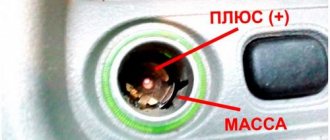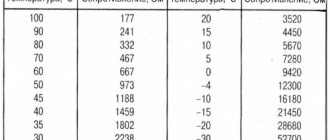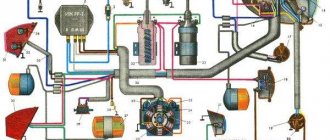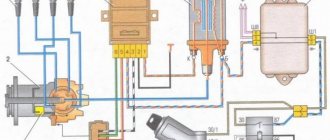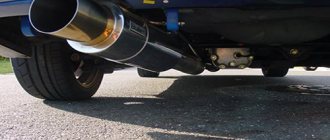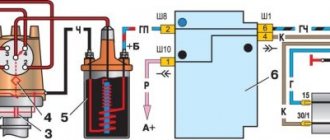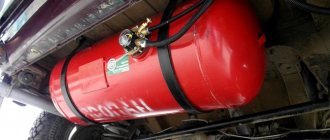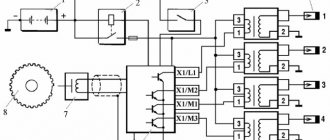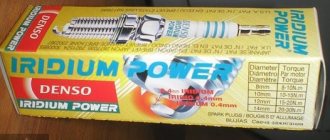Popping noises on machines with HBO
Why is there a popping sound under the hood when you turn on the ignition, mainly on a fuel-injection engine? As you know, after the ignition is turned off, the gas pressure reduction valve shuts off the gas supply. Thus, the operation process proceeds, however, due to wear, dirt clogging and other factors, the density of this valve itself deteriorates, which makes it possible for gas fuel to penetrate into the intake manifold and cylinders.
It should be understood that when the ignition starts, the voltage in the bobbin or ignition module increases. Under some conditions, this leads to the formation of a spark discharge on all spark plugs, causing a fuel explosion in the cylinder and manifold.
The pops are the result of this most unnecessary inflammation. You can repair the valves and gearbox and adjust the density. This will provide some positives, but not for long. As practice shows, the leak will continue, albeit in small quantities, not dangerous in operation, but unpleasant only in terms of the appearance of pops. How to completely eliminate popping noises on cars with LPG?
Additional relays
There are several options, one of which involves adding a pair of relays to the power circuit. This circuit will prevent popping noises that occur when the ignition is turned on. This is what this principle is based on:
- As soon as the ignition is turned on, power goes to contacts 30 of both additional relays;
- The ignition coil remains without power;
- When the starter is engaged, the relay coil is energized;
- Contacts 30 and 87 of additional relays close.
After starting the engine and turning off the starter, voltage is no longer supplied to the additional relays, the contacts open, but the relays remain switched on. A spark on the spark plugs is formed only when the crank shaft rotates. Thus, this scheme will prevent a fuel explosion in the collector.
As a rule, instead of a second relay, many people simply use a diode. It does not require much power.
So, the answer to the question of what is the reason for the shot sounds like this: the valve on the gearbox is to blame, which over time begins to let gas through.
It is noteworthy that you can verify this by switching the power supply from gas to gasoline (using the mode selection button). As soon as the car switches to gasoline, the popping noise stops.
Another interesting point that I would like to focus on. A car with LPG slams, often with a cylinder filled with more than 20 liters. When there is little gas inside the cylinder, there is no popping sound.
Forum → VAZ → 2110 → Engine and power supply
I have the following problem: VAZ 2110, 2006 Guards, eight-valve injector. When the ignition is turned on (without starting with the starter), the intake manifold explodes to shreds (it is made of plastic, which is assembled with the throttle valve). I thought the ignition was off, changed the roller belt, adjusted everything. And yet, after a week of operation, at the first start in the morning (the key is in the first position, without a starter, just turning on the power to the ignition system), a rupture occurred again, again according to the same scenario. Who can tell me what THIS is and how to treat it, otherwise it’s tempting me to change the collector (1200-1400re).
to Maxim19:
is it worth it?
Maxim19: plasma I don’t know what? and what is HBO? #
HBO is gas equipment. Plasmer is heating candles. Powered by on-board computer. Serves for “easy engine starting” in cold weather. In essence, this is a “long” spark on the candle, which heats up the candle stump.
Maxim19: could the cause be a bad engine mass? #
It would be more correct to say the mass of the body. Although this is correct =) The cause of the fire cannot be a bad mass. Only if there is a short circuit, or a broken wire that connects to ground (piezo effect in a lighter) + flammable mixture. Gasoline vapors are especially dangerous.
I don’t use HBO or warm-up, everything is so banal, key + ignition = clap, everything was clear, I wanted to hear useful recommendations from someone.
to Maxim19:
HBO are gas marks, check: 1-mark on the flywheel (main) 2-on the crankshaft gears.3-on the camshaft.4-20th tooth on the crankshaft pulley after the break should clearly look at the crankshaft sensor magnet (the tooth is marked with a white marker) and as an option, some injector(s) are not sealed. If you stretch the mass, it won’t get any worse. For the manifold to burst, it’s the first time I’ve heard something like that, it shoots, I’ve seen it. miracles of the Russian Automobile Industry
to Maxim19:
When I activated the plasma, there was a strong bang under the hood. That's why I asked, since the situation is similar. True, the collector was not blown to pieces in this case. But in your case, if not the plasma, then the plus breaks through to ground where gasoline vapors accumulate. When you turn on the ignition, a spark jumps and the gasoline does this: boom! (more precisely, its pairs)
And what kind of useful recommendations are we talking about? You didn't even answer my very first question.
sorry! No, it doesn’t smell like gasoline, there’s no leakage, it triggers when the ignition is turned on, and the wiring is in good condition. Previously, the upper part of the manifold was made of alloy, but now, for reasons of simplicity, it’s made of plastic, which is not very practical.
to Maxim19:
To prevent spark plug detonation, remove the caps from all spark plugs and turn on the ignition. Just DO NOT confuse them later! Otherwise the ignition coil may burn out. If the cotton does not go away, then look at the injectors. There seems to be nothing left to detonate with gasoline. And if it’s gone, then the ignition coil needs to be checked, it’s shorting out somewhere.
reflash or change the ECU
cook: reflash or change the ECU #
to Djveliar:
Citizens, just in case, on almost all VAZs, when the ignition is turned on, the coils discharge (later a spark on the candles), this is how it should be!
There are two reasons for this.
1) as the person suggested -
Djveliar: and as an option, some nozzle(s) are not sealed #
Yes! it is possible that one or more injectors are not sealed and after some time, fuel from the ramp enters the cylinders, as a result of a warm engine, the fuel evaporates and through the intake valves (and exhaust) enters collector. Consequences of "clap"
2) this HBO is missing the (main) valve; you already know the consequences.
And finally, I had a case, a vacuum tube that comes from the rail pressure valve, the valve allowed a small amount of fuel to pass through, as a result, a little fuel got through the tube directly into the manifold (intake) and you know the result.
I encountered such a problem. the reason is in the injectors.
guys, I found the reason! More precisely, a combination of reasons)) A throttle valve is attached to the intake manifold with two studs, which has several fittings, (4 more precisely), on which pipes are put on, 2 for antifreeze, heating, so to speak, one return, and one (that’s it!) outlet accumulated fuel gases in the manifold (discharged under the valve cover through a thin rubber hose). In the throttle valve this hole is of a very small (tiny) diameter, and it was tightly clogged with engine oil vapors (since it is discharged under the valve cover and you understand there)) , in short, there was nowhere for the pressure to go.
Secondly: the engine weight was made to fit the thermostat stud, it was all soured from antifreeze, in general it was not there (it was constantly knocking from the body when opening and closing the doors), I converted it to the gearbox stud, plus I added another one directly to the throttle stud, plus I added a strip of antistatic agent from the rear bumper to the ground and VOILA.
Conclusion: Impaired ventilation of the intake manifold + bad mass = fun and expensive (RUR 1,300 for the manifold) repair. (And what cotton and chips in different directions)). So it goes)))
I wish you don’t encounter such a problem on the road, do that and be happy.
Popping noises on cars with gasoline engines
As a rule, popping noises on cars with a gasoline internal combustion engine begin when the ignition is turned on, always after the car has been idle. This can be either long-term downtime or short-term.
This is due to the spark slipping in the ignition system without cranking the engine with the starter. In other words, the spark jumps at the wrong time, when it is not needed.
Obviously, if there were not a large amount of exhaust gases, and their high-quality suction through the tube had been established, the spark, no matter how it jumped, would not have caused pops.
It is interesting that this problem often occurs in winter and autumn, less often in spring, and is practically not observed in summer.
Experts also say that installing multiple reels helps solve the problem. The individual coils on the cylinders fully comply with the scheme, when the spark does not jump when the ignition is turned on, but does this only during the rotation of the starter.
Why does the engine shoot into the carburetor: resulting in popping noises
A fairly common problem with carburetor cars is the characteristic popping noise in the carburetor. The malfunction may occur when the engine starts and fires into the carburetor, as well as during operation of the internal combustion engine after the power unit has been started. At the very beginning, we note that experts consider the main reasons to be a severe depletion of the fuel-air mixture, ignition timing, or malfunctions of the gas distribution mechanism associated with incorrectly set phases.
As for the CIS, most carburetor cars on the roads are Russian-made models. Next, we will look at problems when a VAZ engine shoots into the carburetor, why a 406 engine shoots into the carburetor, and also talk about how to detect and fix such malfunctions with your own hands.
The ignition system is to blame for the bang!
Judging by the symptoms described above, the main cause of their occurrence may be a faulty injector. If a bang is heard from below the car or closer to the rear, then unburnt fuel has exploded in the muffler.
Cotton on VAZ-2112 engine 21120 (video)
Cause of popping
If you have a question about why exactly the injector is faulty, then below we will try to explain it to you.
- When you turn off your car and get out of the car, residual pressure remains in the fuel rail, which presses on the injectors. And since worn-out injector nozzles “snot”, they leak some of the fuel into the cylinders.
- And at the moment when you start the engine again, a spark occurs from the spark plugs, and the fuel that has accumulated during the entire time it flowed down the cylinder walls ignites. And since its amount is incommensurate with the combustion chamber, a kind of bang occurs.
Difference in operation of a working and faulty injector
You can read about how to dismantle and clean the injectors yourself in this article.
What to do if the engine shoots into the carburetor and muffler
The appearance of popping noises in the muffler and carburetor is usually accompanied by a whole list of other symptoms:
- the engine “shoots” and does not start;
- work at XX is extremely unstable;
- the engine loses power and does not “pull”;
- the motor is prone to overheating;
- fuel consumption increases noticeably;
In this case, the unit’s response to pressing the gas pedal is not clear; delays and dips appear; the machine may jerk under load and in transient modes. In the language of ordinary car enthusiasts, the engine begins to “sneeze.” If the carburetor shoots when starting the engine, and the additional symptoms described above are also present, then certain elements and settings should be checked.
Diagnostics of the ignition system and OZ settings
The check should begin with the high-voltage wires of the ignition system. Violating the order of their connection will lead to the fact that the moment of spark formation on the spark plug will not occur at the end of the compression stroke, and the very order of supplying sparks to the cylinders during engine operation will also be disrupted. In this case, the engine may start, but during operation there will be shooting in the carburetor, which will be repeated at certain intervals. To solve the problem, you should connect the wires to the spark plugs, taking into account the fact that there are special marks on the distributor cover. These labels will help you make connections in the correct order.
If the engine shoots into the carburetor, the reason may be early ignition. This means that the spark appears too early. In other words, the mixture does not ignite at the end of the compression stroke, but at the moment the piston begins to approach TDC, completing the stroke.
In this case, the mixture of fuel and air in the cylinder burns untimely, as a result of which the combustion process is disrupted. The result of early combustion is a “lumbago” in the form of a pop in the carburetor. With late ignition, popping noises can go into the muffler, since combustion is still ongoing when the intake valve begins to reopen on the next stroke. Moreover, the combustion of the remaining mixture also extends to a new portion of the fuel charge, which is sucked into the engine from the carburetor into the intake manifold during intake. Under such conditions of disrupted combustion, the engine overheats. Often late or early ignition can be determined by the condition of the spark plugs. If the spark plugs are white, with carbon deposits, etc., then the OZ needs to be checked and set by adjusting the ignition timing. This adjustment is made by turning the distributor in accordance with the scale.
You should also check the Hall sensor and pay attention to the ignition distributor bearing. Problems with bearing fastening or other nuances may indicate the need to replace the distributor. Let us add that during diagnostics it is optimal to install an initially serviceable device on the car, which will allow faster and more accurate localization of faults in the ignition distributor. Similar actions should be performed with the ignition system switch. If it breaks down, sparking is disrupted and the spark itself is not supplied at exactly the specified moment.
Lean mixture: carburetor and fuel system
Running a carburetor engine on a “poor” fuel-air mixture often leads to the formation of pops and shooting in the carburetor. This phenomenon occurs because the lean mixture burns too slowly. The problem resembles an ignition failure, that is, the lean mixture burns after a new intake stroke has begun. It turns out that after exhaust, the intake valve opens on the intake stroke, and the lean fuel mixture still burns out in the combustion chamber. The incoming portion of the mixture also lights up. As a result, cotton is created in the intake, which reaches the mixing chamber of the carburetor itself. It should also be remembered that a lean working mixture is one of the main reasons for engine overheating.
Crackling noise under the hood when the ignition is turned on
If when you turn the ignition key you only hear a loud crash from the engine compartment, do not rush to immediately blame the starter for all your troubles. There may be several reasons for this phenomenon, and a breakdown of the starter retractor relay is just one of the most common malfunctions. Today we will talk about why the starter began to crack and what to do to restore its functionality.
Causes of malfunction
Before we begin to study the causes of the malfunction, we remind you that hereinafter we are talking about the crackling noise of the starter, which is most similar to the loud rattling of the contacts of an electromagnetic relay. If you hear an unpleasant metallic grinding noise from under the hood, then it appears due to poor engagement of the overrunning clutch (starter Bendix) with the flywheel teeth - that’s a completely different story.
Most often, the starter crackles when you turn the ignition key for three reasons:
Low battery
To understand the cause of the crackling noise due to a discharged battery, let's remember the starter device. When you turn the ignition key, the voltage from the on-board network is supplied to the coil of its solenoid relay. The electromagnetic forces that appear in this case cause the armature of the device to move. It closes the power contacts that connect the starter motor to the battery, and in addition, causes the Bendix gear to engage with the flywheel.
When the battery is discharged, its energy may be enough to attract the metal core - cranking the crankshaft is out of the question. As soon as the starter contacts close and power is supplied to its electric motor, the voltage drops to such an extent that the electromagnet is unable to hold the metal core. Under the action of the return spring, it tends to take its original position and opens the power contacts. The restored voltage contributes to the repeated retraction of the anchor, and the situation is recreated many times.
To make sure that the culprit of the problem is a deep discharge of the battery, just turn on several consumers (lighting, electric heater motor, etc.) and press the sound signal. The latter will either not turn on at all, or will be heard with wheezing, reduced amplitude or attenuation.
Poor engine ground contact
The picture of what is happening is practically indistinguishable from the case discussed above, with the only difference that the test for battery discharge ends with a negative result - all consumers, including the sound signal, are working at full strength.
At the same time, it is very simple to determine that the cause of the malfunction is poor contact between the battery and the engine - just pay attention to the oil pressure warning lamp, which is located on the instrument panel. If the voltage in the car’s on-board network is below normal, then turning the ignition switch to the “Start” position will lead to a gradual attenuation of the brightness of the warning lamp (like all others).
